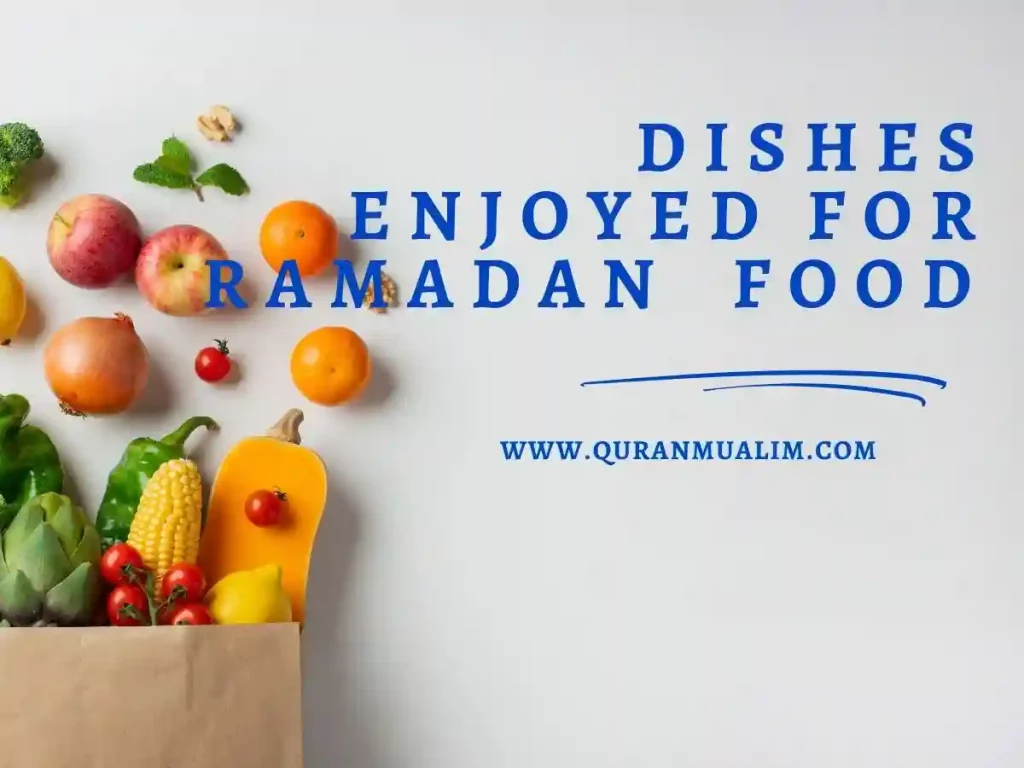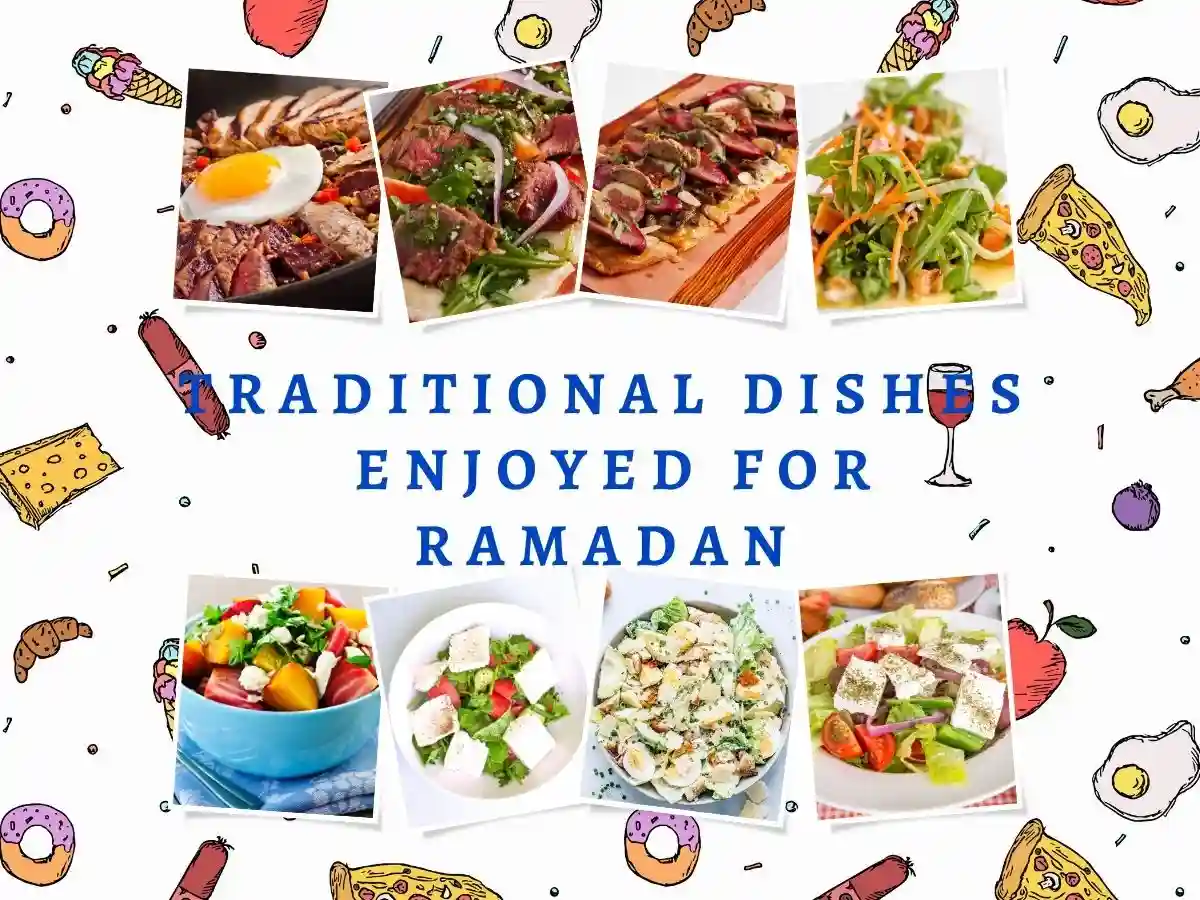Traditional Dishes – It is almost time for the month-long celebration of Ramadan. Ramadan is a lunar-based Islamic festival that varies every year. Due to different interpretations of the calendar, some communities start the month earlier or later.
The festival is centered around the five pillars that make up Islam. These include prayer (salat), giving alms (zakat), fasting (sawm), and more. All month long, the able Muslims will fast from dawn until sunset.
This fast is to show spiritual discipline, commitment to Allah, and to remind us to support and empathize those who are less fortunate.
Ramadan, despite its apparent contradiction, is a food-focused holiday. Suhoor is a light meal that gives energy and sustenance throughout the day. It usually includes milk, dates and other cultural favorites.
Families break their fast after the sun has set with Iftar, which is a large meal. According to Islamic teachings, Allah will bless those who provide Iftar and will ensure that they never again experience hunger or thirst.
Eid al-Fitr is celebrated at the end of Ramadan with banquets and gift-giving. Islam was born in Saudi Arabia but has spread rapidly to all five continents. Each country has a unique cultural food associated with Eid al-Fitr. We’ll be exploring many of these today.
Also Read: Chops & Steaks The Real Meat Fresh Halal Meat

Dates are everywhere
You may have noticed, if you live in an area with a large Muslim population, that your local grocery store has begun stocking dates more than usual. Why?
Eating dates to end the Ramadan fast is a tradition that has been around for centuries and was inspired by Prophet Muhammad. According to Islamic Scripture, the Prophet Muhammad broke his fast with three dates and water.
It’s not surprising that many devout believers follow his example, since dates are rich in natural sugars. They also provide energy to those who have fasted. There are more than 200 varieties of dates, but medjools are the most popular due to their unique flavor and sweetness.
Also Read: 1 lb Boneless Skinless Chicken Thighs Calories
Did you know there were bakeries for everyone in Ottoman times: the military, the general public, the embassies and the charity? The bakeries of the past are no longer there, but the streets of Istanbul still have a plethora.
People wait in line for hours during Ramadan to buy freshly baked Ramazan Pidesi, an airy leavened loaf. The distinctive indentations, sesame seeds and nigella seed toppings give it an unique look.
Suhoor is characterized by a lavish spread of Turkish coffee, labneh and jam along with the fluffy bread. If you prefer a heartier meal, try cilbir (Turkish Eggs) with the fluffy bread.
Also Read: Campbell’s Low Sodium Chicken Noodle Soup
Qatayef in Egypt
When you see qatayef in the shops, it’s a sign that Ramadan is approaching. The sweets are eaten exclusively during Ramadan and have become a symbol of festive spirit not only for the Egyptians but also all North Africans and Middle Easterners. Qatayef’s main ingredient is a flour, semolina and yeast pancake that is only cooked on one side. There are two popular versions. The first is filled with ashta, or sweetened clotted cream, and then topped with nuts. It is drizzled with honey. While the second is sealed, fried and soaked with sugar syrup. The market sells stacks of pancakes that are assembled at home.
Also Read: Best Butter Chicken Sauce in A Jar
Chorba frik, Algeria
Soup is a great choice for those who want a warm, comforting meal. The Maghreb’s speciality, chorba frik (Algeria Libya Mauritania Morocco Tunisia), is a hearty stew that is served during the winter and a part of Ramadan. The sauce is thick and spicy, with spices like cinnamon, paprika and turmeric. The main ingredient in this dish is freekeh. This ancient grain originated thousands of years ago. It has an earthy, nutty taste that complements the delicate chickpeas and succulent meat.
Also Read: Bismillah Grocer & Halal Meat
Knafeh, Palestine
Other countries have also enjoyed cheese-based desserts for centuries. The Middle East is home to a prized dessert called Knafeh, also known as kunafa or kanafe. However, its origins are still debated. Some historians claim that the dessert originated in Palestine. Others say it was created in Egypt or Syria. Knafeh’s floral aroma and sweet taste has been enchanting people for centuries. The base is mozzarella. It is then topped with phyllo flakes (called kataifi) and baked until golden. The knafeh is finished with a sweet floral syrup that’s scented with orange and rose blossoms.
Also Read: Halal Cheese List – Learn Islam
Haleem Pakistan
Slow cooking is key to creating a delicious haleem, a traditional Pakistani dish rich in aroma and flavor that will tantalize your taste buds. Haleem is made by cooking meat, grains, nuts, spices, and lentils until they become unctuous. To enhance the flavor, they usually add julienned onions, caramelized ginger, and fresh cilantro. The Nizams in Hyderabad, India popularized this dish that has roots in Iran. When many Muslims fled from India to Pakistan, haleem became a speciality.
Also Read: Is Daves Hot Chicken Halal?
Harira, Morocco
The Moroccan cuisine is full of flavor and variety, but harira is a must-have on any Iftar menu. The traditional Moroccan soup is full of flavor, and is surprising to many, often made from plants (although certain interpretations include meat). The name comes from the Arabic “harir,” which means silk, and refers to its smooth texture. The dish is also packed with chickpeas and lentils as well as parsley, cilantro celery, vermicelli ginger and warm spices. Fresh herbs give the dish a zesty touch, and the pulses provide comfort. The whole country enjoys a steaming bowl of harira and crusty bread at Iftar.
Also Read: Is Halal Wingstop Halal?
Kuih lapis, Indonesia
Kue lapis, an Indonesian steamed cake with a stunningly layered design, is one of the most colorful Ramadan treats. The colorful dessert is also popular in Malaysia where it’s called “kuih.” Chefs use a variety natural ingredients native to Southeast Asia, such as butterfly pea flower, pandan leaves and rose syrup to give the layers vibrant colors. Coconut milk and cane-sugar sweetness add creaminess to the texture, which is made soft by indigenous ingredients like glutinous and tapioca. Street vendors sell kue lapis as the month of Ramadan ends and Eid al-Fitr nears. This delicious dessert is made by more traditional families using age-old methods.
Also Read: Is Extra Gum Vegan?
Patir, Uzbekistan
In the past, Uzbekistan and much of Central Asia were muslim countries. All that changed in 1924. The Soviet Union invaded Uzbekistan, and forced its citizens to adopt the atheistic state religion. The perpetrators destroyed the mosques, burnt Arabic texts and barred Muslims to hold office. In 1991, the Uzbeks who make up 90% of Uzbekistan’s population were finally allowed to practice their religion freely. Ramadan is a relatively private event in modern times. This may be due to the country’s dark past. It’s not uncommon for the head family member to lead a communal prayer and then break the fast in the evening with patir – a crisp, buttery, traditional tandoor baked bread.
Suggested Read : What Does Guanabana Taste Like?
Zoolbia in Iran
You may be familiar with South Asian food, as zoolbia is similar to Indian jalebi. They even have the same ingredients. The batter is fermented with saffron and yogurt for one hour before being piped into hot oils in spiral shapes. After frying, zoolbia are quickly dipped in a rose-scented syrup to give it a crunchy texture. During Ramadan people often pair zoolbia, a sweet pastry that looks like churros or a donut, with hot tea and bamieh. These traditional treats are paired with milky beverages to create a delicious and comforting treat for the festive season.
Suggested Read: Where To Buy Jamun Fruit in USA?
Bamia (Lebanon)
We know. The okra, or ladies’ finger as it is sometimes called affectionately, is a vegetable that divides people. Some people are turned off by slimy okra, but others love the juicy pieces of okra in a hearty Gumbo. Lebanese cooks know how to make the most of okra. Even the most staunch okra-haters will be won over by the traditional bamia. It is a hearty and robust okra stew with meat. This dish is infused with flavors from Lebanese classic spices, tangy tomato molasses and rich pomegranate.
Suggested Read: Are Tootsie Rolls Halal In Islam?
Nafaqo in Somalia
Have you ever heard of nafaqo, the Somali cousin of Scotch egg? Both dishes are unknown; some claim they’re based on the Indian nargis-kofta while others say that they have similarities with snacks from North Africa. The Somali nafaqo, unlike most similar versions of the dish is vegetarian. At its center is a soft-boiled yolk wrapped in delicately spiced mashed potatoes and then covered in crisp breadcrumbs. This delicious breakfast is also a Ramadan favorite. The name “nafaqo,” which means “nutrition” in Somali, is the reason why it has remained a popular food for fasting to this day.
Suggested Read: Are Welch’s Fruit Snacks Halal?
Malaysian food is renowned around the world for its complex flavors and deceptively hot foods. We bet that you’ve never tried ayam merah – a chicken dish with a mild sauce and a rich aroma. This dish is a must-have in Malay Muslim households on Eid al-Fitr. We recommend gathering ingredients and cooking it yourself when you have the opportunity.
The base of many ayam merah dishes is sambal. This condiment is made with dried red chilies and aromatics such as shallots, garlic, ginger and lemongrass. The sambal adds a gentle heat to this otherwise mild dish. It is perfect for eating with ghee-rice (nasi mintyak).
Suggested Read: Is Beef Bacon Halal (Halal Meat)
Khaliat al nahl, Yemen
Do you like sweet breads, such as cinnamon buns or babkas? If you love sweet bread, like cinnamon buns and babka, then Yemeni khaliat a nahl is a must-have for your Iftar spread. The name translates as “honeycomb-shaped buns” and refers to the unique design of the dessert, which mimics the honeycomb pattern. Each fluffy, cloudlike bun is filled with sweet cream cheese. It’s topped with sesame seeds and nigella. Honeycomb bread would not be complete without a sweet floral honey. These delicious buns are perfect for sharing and can be easily torn apart. They taste amazing when dipped into Yemeni coffee – some of the best in the world.
Suggested Read: Are Sweet Tarts Halal?
Doro wat Ethiopia
Ethiopian cuisine is not given the credit it deserves. This is especially true when you consider dishes such as Doro Wat. This spicy chicken stew is the unofficial national food of Ethiopia. It’s also a Ramadan treasure that shouldn’t be missed. This dish is made up of tender chicken, a buttery sauce known as kulet, fiery berbere spices, and hard-boiled egg. This dish is irresistible because it has a rich flavor only achieved by slowly caramelizing the onions and drawing out their sweetness. The best way to serve it is with injera, a fermented bread.
Shorbat adas, Jordan
Vegetarians rejoice. You may think that plant-based foods are limited because most Muslim cultures are known for their rich, hearty dishes. Shorbat adas is a warm red lentil soup that originates from Jordan and Lebanon. These lentils, seasoned with earthy spice blends, are simple but flavorful. Add some lemon juice to the top of your dish to give it a new dimension. As it is light and refreshing, shorbat-adas is traditionally served as the first course at the Iftar meal.
Jollof rice, Nigeria
This vibrant one pot meal is a favorite in Nigeria, Ghana and Senegal. Each country claims to have the best recipe for jollof. The meal is made up of long-grain fluffy rice, cooked in a tomato-based sauce and seasoned with curry powder, dried bay leaves, and fiery thyme. Jollof rice can be served with crispy-fried fish or chicken and garnished by fried plantains or coleslaw. Nigerians are fervent in their celebration of Ramadan, as they have the largest Muslim population on the continent. Everyone agrees that the celebration wouldn’t be complete without large plates of their national dish jollof.
Falooda, Bangladesh
By Ramadan in Bangladesh, the weather is already stiflingly warm and sunny. Falooda, a sweet and refreshing drink that is popular in the region, can help. To sweetened milk, add a mixture sweet vermicelli, chilled rose syrup jello and tapioca pearls. Also, chopped nuts, basil seeds and tapioca are added. Bengali falooda traditionally comes in a tall, clear glass, topped with extra nuts and strands saffron, as well as a scoop or two of vanilla ice-cream. This complex dessert combines different textures and flavors with stunning visual effects. It is a must-have after a day of not eating or drinking.
Also Read: Dum Dum Ingredients & Recipe
M’battan, Libya
Fried potatoes are one of the foods we cannot resist. Potatoes are a versatile and widely loved vegetable. Almost every country has a variety of snacks made with crispy-cooked potatoes. M’battan is the preferred dish in Libya. It can also be spelled as mubattan or Batata mbatna. They’ve created something better than a potato fry – crispy on the outside and soft on the interior, potato slices filled with garlicky minced meat. It’s a little tricky to put together, but the m’battan will be worth it once you get started.
Also Read: Halal Guys Red Sauce Recipe
Dolma, Iraq
According to legend, Alexander the Great was a fan of the Greek tradition of wrapping leftovers with vine leaves. Alexander the Great was so impressed with the Greek tradition of wrapping leftovers in vine leaves that he brought it into his military kitchen. He also took this technique everywhere he went to spread the love for the delicious dish.
What is exactly dolma, then? Wrapping seasoned rice, vegetables or minced beef in vine leaves is a tasty treat. The leaves are then steamed and served with a sweet-sour pomegranate syrup. This finger food is enjoyed by Iraqis as well as their neighbors during their Iftar meal.
Also Read: Top 10 Best Halal Food Astoria
Bean Pie (U.S.
You may not immediately think of American food as being served at the Iftar. Islam is still the third largest religion in the U.S., after Christianity and Judaism. It has over 3.5 millions adherents. Some of these followers brought their culinary delights with them to the U.S. while others created new dishes. One such dish, bean pie, has a long history that dates back to the Black Muslim communities of the 1930s. The founder of “Nation of Islam,” an era-wide movement, advised his followers not to consume unhealthy starches, as well as haram food like alcohol, pork and gelatin. Many desserts were off limits, but bakers used their imagination to create the famous bean pie. This creamy, silky dessert is made with navy beans. You may not like it, but we guarantee you will be converted.
Arroz caldo, Philippines
Don’t you think that the best food is comforting? These meals are delicious, whether they’re food from our childhoods or foods that instantly bring us back to a cozy feeling. Arroz caldo is the national dish of the Filipinos and it’s a healthy, homey meal for Iftar. Arroz caldo is a dish that combines chicken, ginger and garlic with a creamy, warm rice in a flavorful broth. It’s topped with crispy garlic fried and scallions. Soft-boiled eggs can be added to the porridge for those who want a bit more protein. The silky yolk adds a rich flavor and nutritional value.
Also Read: The Role of Halal Food Healthy in Life
Samosa, India
India is still a predominantly Hindu nation, but there’s a significant Muslim minority of around 200,000,000 people. This makes India the country with the third largest population of Muslims. Ramadan in India is an exciting time, particularly in major cities like Hyderabad and Delhi. Iftar meals include a variety of curries, rice, bread and other dishes. But one snack is always on the table. Samosas can be deep-fried or air-fried pastries made with golden flaky pastry, spiced potatoes, and peas. Combine them with raita, chutney or any combination curries.
Also Read: List of Top Halal Chips Brands With Review
Chebab United Arab Emirates
United Arab Emirates is one of the richest countries in the World, and this is reflected by its vibrant restaurant culture. Chefs have access to a variety of imported ingredients that they can use to create culinary delights. Emirati Chebab is a popular dish in the country, especially during Ramadan. This delectable treat is made by blending saffron with warm milk and cardamom to make a batter. Then, cook the pancake on a hot frying pan. The chebab is finished with date syrup or honey.
Also Read: Fruit By The Foot Ingredients: Nutrition & Ingredients
Ma’arouk in Syria
Some desserts are only served during Ramadan. Pillowy ma’arouk is a popular treat in Syria and Lebanon. Children and adults alike are eager to try the brioche like bread. Ma’arouk dough, infused with fragrant mahlab and stuffed with date paste, finely chopped nuts and mixed nuts creates a sweet, spicy mix that is integral to its flavor.
Ma’arouk, traditionally, is baked into a wreath and brushed with a citrus-infused syrup. It can be served with a variety of cheeses, jams, hot tea or coffee.
Our Latest Ramazan Articles:
- Ramazan Apps You Must Have
- How To Enjoy Ramadan With Menstruation?
- Ramazan Increases Women’s Responsibility
- 5 Beautiful Ramadan Duas Every Muslim Should Know
- Ramadan Supplications: Qualities Of A True Servant
- Ramadan Mubarak: Hear Greetings in Different Languages
- Ramazan Healthy Recipes To Open And Close Your Fast With
- 7 Heart Warming Duas To Celebrate The End of Ramadan 2024
- What is The Celebrate Ramadan? Here are 5 Unique Traditions
- Ramadan Recipes For Kids: A Collection Of Fun Kid-Friendly Recipes
- Ramazan Begins With Varied Fasting Hours Across The World Wide
- Select 7 Heart Warming Duas To Celebrate The End of Ramadan 2024
- Fasting Begins on Thursday in Saudi Arabia Despite There Being No Ramazan Moon








